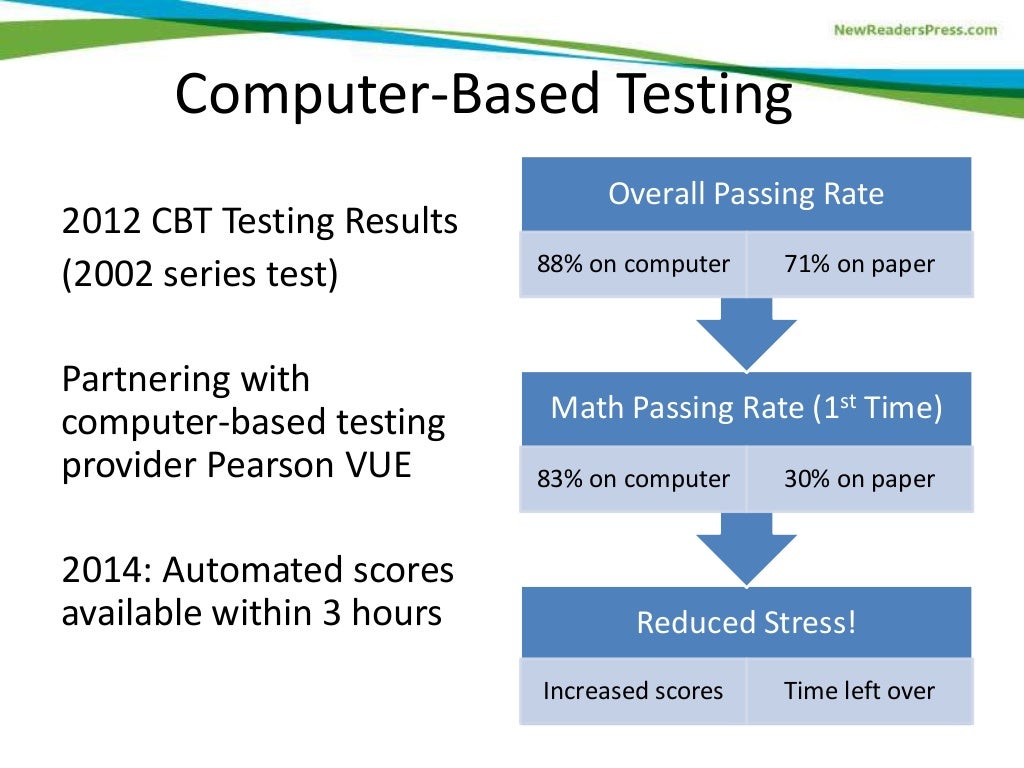Chapter 11 – Gintert & Leach
 |
How has Technology Been Integrated into the way Adults have Been Prepared to Pass the GED in Ohio? |
Table of Contents
What is the GED test?
History of the GED test
GED in the State of Ohio
GED Preparation Programs
Technology in GED Preparation Programs
Things to consider about technology in GED Preparation Programs
What does the future hold?
What is the GED test?
 |
What can you share about the history of your office and the GED prep in Ohio? |
 |
How did Person Review become the test provider? Is it a national contract? How did that process work? |
GED Preparation Programs
Technology in GED Preparation Programs
 |
So what has been the experience with technolgy at ABLE (now Aspire) and in GED prep? |
Information and research on technology incorporation in GED preparation programs is minimal. We know that the preparation started in classrooms and that one of the first advancements was in 1993, when the GED preparation program was available as a program on television. The program was called “GED – Get IT!” and was broadcast by more than 200 public television stations. The one-hour program “encouraged viewers to study for and take the Tests of General Educational Development (GED)” (ACE, pg. 57). Simultaneously, ACE widely aired ads on commercial radio and television as a public service announcement, encouraging adults to take the GED. The state of Maryland started the process several years earlier and had celebrity commercials to encourage participation. One particular ad featured Sugar Ray Leonard. The commercial was released in 1987. Watch it here. Recently, in 2012, there is the Pep Talk Center sponsored by Dollar General. It consists of several celebrities offering encouragement, like Danny Trejo and Ron Perlman. They look to entertaining and inspiring. The celebrities tell the participant to enter their zip code and find free local classes. Christopher Lloyd is a favorite with 1,097 views.
As noted in the timeline above, the biggest leap in GED test with respect to technology is that the GED test is offered on computers. But what about when GED preparation classes themselves and the incorporation of technology for the GED test taker? Little research and information is available. One particular GED instructor, Farrell, discussed this during a talk at a ProLiteracy conference in 2013. During the presentation, from minute 9:51 to 14:33, she talks about the concern GED instructor and facilitators had with the tests movement from paper to computers. She mentions that the positive aspect of computer-based testing is that the results are automated and available fairly quickly, 3 hours in Ohio. But the concern is that the GED test taker needs to know how to use take the test. GED testing service did a usability study. The usability study consisted of a group of test takers. GED testing service took the existing computer based test and put it on computer and disovered 500 errors. The overall results however was astounding. The passing rate was better and it reduced stress.

This slide was taken from Farrell’s presentation. It is slide 11 of 45. Meagen is a true advocate for technology in GED preparation. She urges other instructors and department employees in her presentation to consider usability when assessing programs for their participants. Further on in the presentation she talks with the group about incorporating technology into the GED preparation classes. One participant from Texas emphasized concerns changing her method from a projector to computer based practice. She worried how to adjust. One recommendation was using a clicker or to utilize the internet or even using twitter (minute 28:24 to 31:37). The entire presentation is available on YouTube or her website Farrellink.com.
 |
When you switched to the computer based version of the test, did you notice a drop in people looking for prep help? |
Despite extensive searching, it was difficult to find any additional information on technology in GED preparation. It seems that further research needs to be done on the subject. We were surprised to not find studies on the equipment needs or uses in GED preparation with respect to test success or number of times the test was taken. It would be interesting to research a true timeline and perhaps the only way to gather the information is to interview ACE or perhaps GED instructors.
 |
Have you guys had any technology that you impemented and it didn’t work out? If yes, then why did you stop using it? |
 |
Do you do any GED prep testing online? |
Things to Consider about Technology in GED Preparation Programs.
Technology costs money.
Technology learning curve.
 |
Do you spend a lot of time teaching people how to use technology? |
What does the future hold?
 |
Do you see technology as a benefit to these programs? |
 |
Do you know of any legislation that is being created that would impact your area? |